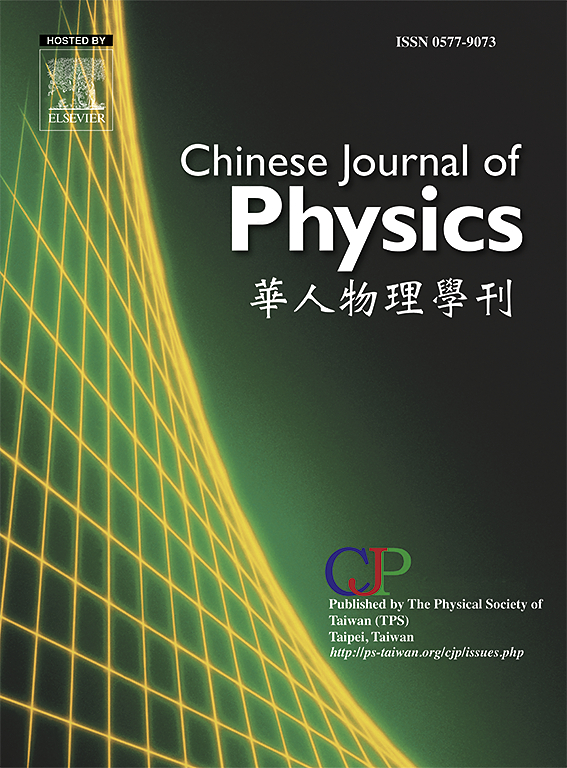Minimally deformed wormhole solutions with holographic dark energy and mixed energy density in dRGT gravity
IF 4.6
2区 物理与天体物理
Q1 PHYSICS, MULTIDISCIPLINARY
引用次数: 0
Abstract
This study explores static, spherically symmetric wormhole solutions within the framework of massive gravity (dRGT) de Rham–Gabadadze–Tolley (dRGT) for the first time, incorporating mixed-energy density and holographic dark energy (DE) density profiles using the Minimal Geometric Deformation (MGD) method proposed by Ovalle (2017). Using unique density profiles, the corresponding shape functions are calculated. The key characteristics of wormholes, including flaring-out condition and asymptotical flatness, are examined in depth. Through the MGD approach, this study constructs wormhole solutions, with the decoupling parameter serving as a key factor influencing their geometry and energy constraints. The embedded diagrams illustrate the upper and lower universes, which are influenced by the effects of newly determined shape functions. In addition, the volume integral quantifier () is evaluated, shedding light on the exotic matter required near the wormhole throat. The stability of the wormhole solution is confirmed by satisfying equilibrium criteria through the balancing of different forces. Both models suggest that real-world wormhole solutions are feasible due to the increasing active gravitational mass (). Through a detailed analysis of shape functions, the study addresses how thin-shell wormhole stability is influenced by mass, geometric structure, and decoupling parameter, offering practical insights into constructing stable configurations in theoretical models.
dRGT重力下具有全息暗能量和混合能量密度的最小变形虫洞解
本研究首次在大质量重力(dRGT) de Rham-Gabadadze-Tolley (dRGT)框架下探索静态球对称虫洞解,使用Ovalle(2017)提出的最小几何变形(MGD)方法结合混合能量密度和全息暗能量(de)密度剖面。利用独特的密度曲线,计算相应的形状函数。深入研究了虫孔的关键特性,包括渐近平面性和渐近发散条件。通过MGD方法,本研究构建了虫孔解,其中解耦参数γ是影响其几何和能量约束的关键因素。嵌入的图表说明了上层和下层宇宙,它们受到新确定的形状函数的影响。此外,对体积积分量子(VIQ)进行了评估,揭示了虫洞喉部附近所需的外来物质。通过不同力的平衡,证实了虫洞溶液的稳定性。这两种模型都表明,由于活跃引力质量(AGM)的增加,现实世界的虫洞解是可行的。通过对形状函数的详细分析,研究了薄壳虫孔稳定性如何受到质量、几何结构和解耦参数的影响,为在理论模型中构建稳定构型提供了实际见解。
本文章由计算机程序翻译,如有差异,请以英文原文为准。
求助全文
约1分钟内获得全文
求助全文
来源期刊

Chinese Journal of Physics
物理-物理:综合
CiteScore
8.50
自引率
10.00%
发文量
361
审稿时长
44 days
期刊介绍:
The Chinese Journal of Physics publishes important advances in various branches in physics, including statistical and biophysical physics, condensed matter physics, atomic/molecular physics, optics, particle physics and nuclear physics.
The editors welcome manuscripts on:
-General Physics: Statistical and Quantum Mechanics, etc.-
Gravitation and Astrophysics-
Elementary Particles and Fields-
Nuclear Physics-
Atomic, Molecular, and Optical Physics-
Quantum Information and Quantum Computation-
Fluid Dynamics, Nonlinear Dynamics, Chaos, and Complex Networks-
Plasma and Beam Physics-
Condensed Matter: Structure, etc.-
Condensed Matter: Electronic Properties, etc.-
Polymer, Soft Matter, Biological, and Interdisciplinary Physics.
CJP publishes regular research papers, feature articles and review papers.
 求助内容:
求助内容: 应助结果提醒方式:
应助结果提醒方式:


